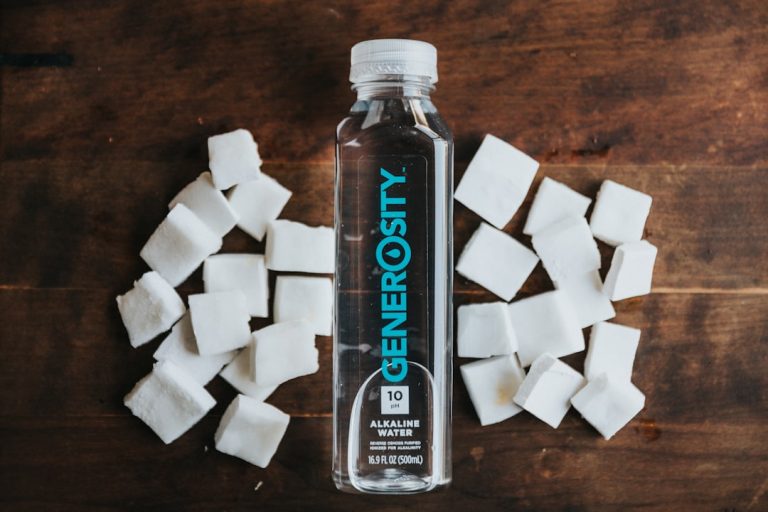Sugar plays a crucial role in the production of rye products, particularly in the fermentation process. Rye flour contains natural sugars that are essential for the fermentation of yeast, which is necessary for the leavening of rye bread and other rye-based products. During fermentation, the yeast consumes the sugars in the rye flour and produces carbon dioxide gas, which causes the dough to rise and creates the characteristic airy texture of rye bread. Additionally, sugar is also used as a sweetener in some rye products, adding a touch of sweetness to balance the earthy and slightly bitter flavor of rye flour. In essence, sugar is not only a key ingredient for the fermentation process but also contributes to the overall flavor profile of rye products.
In rye production, sugar also acts as a food source for the yeast, providing the necessary energy for fermentation. Without sugar, the yeast would not be able to produce enough carbon dioxide gas to leaven the dough, resulting in a dense and heavy texture in the final product. Therefore, sugar is essential for ensuring that rye bread and other rye-based products have the desired light and airy texture. Moreover, sugar also contributes to the browning of the crust during baking, adding a desirable color and flavor to the finished rye products. Overall, sugar plays a multifaceted role in rye production, from facilitating fermentation to enhancing texture and flavor.
Key Takeaways
- Sugar plays a crucial role in rye production by providing food for yeast during fermentation and contributing to the flavor and texture of the final product.
- Adding sugar to rye products can enhance their flavor and aroma, making them more appealing to consumers.
- Sugar can also improve the texture and mouthfeel of rye products, creating a more enjoyable eating experience.
- By extending the shelf life of rye products, sugar helps to reduce food waste and increase the product’s availability to consumers.
- While sugar can impact the nutritional profile of rye products, exploring different types of sugar can help balance sweetness and health benefits in the final product.
Enhancing Flavor and Aroma with Sugar
Sugar is not only a source of sweetness but also plays a significant role in enhancing the flavor and aroma of rye products. When sugar is added to rye dough, it not only provides sweetness but also contributes to the overall flavor profile by balancing the natural earthy and slightly bitter taste of rye flour. Additionally, sugar undergoes caramelization during baking, which adds depth and complexity to the flavor of rye bread and other rye-based products. The caramelization process creates a rich and nutty aroma that enhances the overall sensory experience of consuming rye products.
Furthermore, sugar can be used to create a variety of flavored rye products by incorporating different types of sugars such as honey, molasses, or maple syrup. These natural sweeteners not only add sweetness but also impart unique flavors and aromas to rye products, ranging from floral and fruity notes to rich and robust undertones. By experimenting with different types of sugars, bakers can create a diverse range of rye products with distinct flavor profiles, catering to a wide range of consumer preferences. In essence, sugar serves as a versatile ingredient that not only adds sweetness but also enhances the overall flavor and aroma of rye products, making them more appealing to consumers.
Improving Texture and Mouthfeel in Rye Products
In addition to its role in fermentation, sugar also plays a crucial role in improving the texture and mouthfeel of rye products. When sugar is added to rye dough, it acts as a tenderizing agent, helping to soften the gluten in the flour and create a more tender and moist crumb in the final product. This results in a softer and more palatable texture, making rye bread and other rye-based products more enjoyable to eat. Moreover, sugar also contributes to the overall mouthfeel of rye products by adding a subtle creaminess and smoothness to the texture, enhancing the overall eating experience.
Furthermore, sugar can be used to create a variety of textured rye products by adjusting the amount of sugar added to the dough. For example, adding more sugar can result in a softer and more cake-like texture, while reducing the amount of sugar can lead to a denser and chewier texture. By manipulating the sugar content, bakers can tailor the texture of rye products to meet specific consumer preferences, offering a diverse range of options to cater to different tastes. Ultimately, sugar serves as a versatile ingredient that not only improves the texture but also enhances the overall mouthfeel of rye products, making them more enjoyable to consume.
Extending Shelf Life with Sugar
| Types of Sugar | Effect on Shelf Life |
|---|---|
| Granulated Sugar | Helps preserve texture and moisture in baked goods |
| Honey | Acts as a natural preservative due to its low water content and acidic pH |
| Maple Syrup | Contains antimicrobial properties that can extend shelf life |
| Molasses | Provides a rich flavor and helps retain moisture in baked goods |
Sugar plays a crucial role in extending the shelf life of rye products by acting as a natural preservative. When sugar is added to rye dough, it binds with water molecules, reducing water activity and creating an environment that inhibits the growth of microorganisms such as bacteria and mold. This helps to prevent spoilage and prolong the freshness of rye bread and other rye-based products, allowing them to maintain their quality for a longer period. Additionally, sugar also contributes to the moisture retention in rye products, preventing them from becoming stale and dry over time.
Moreover, sugar can be used in combination with other preservatives such as salt or vinegar to further enhance the shelf life of rye products. By incorporating these ingredients into the recipe, bakers can create rye products that are not only delicious but also have an extended shelf life, reducing food waste and ensuring that consumers can enjoy fresh rye products for a longer duration. In essence, sugar serves as a natural preservative that helps to maintain the quality and freshness of rye products, making them more convenient and economical for consumers.
The Impact of Sugar on Rye’s Nutritional Profile
While sugar plays a crucial role in the production of rye products, it also has an impact on their nutritional profile. Rye flour contains natural sugars that are broken down during fermentation, resulting in a lower sugar content in the final product compared to other types of bread made with refined flour. This makes rye bread and other rye-based products a healthier option for consumers looking to reduce their sugar intake while still enjoying baked goods. Additionally, the natural sugars in rye flour provide a slow-release source of energy, helping to maintain stable blood sugar levels and prevent energy crashes.
Furthermore, sugar can be used in moderation to enhance the nutritional profile of rye products by incorporating natural sweeteners such as honey or maple syrup. These alternatives not only add sweetness but also provide additional nutrients such as vitamins, minerals, and antioxidants, contributing to the overall health benefits of consuming rye products. By using natural sweeteners instead of refined sugar, bakers can create rye products that are not only delicious but also offer added nutritional value, appealing to health-conscious consumers. In essence, while sugar does have an impact on the nutritional profile of rye products, it can be used strategically to enhance their health benefits.
Exploring Different Types of Sugar for Rye Production

In rye production, there are various types of sugars that can be used to create a diverse range of products with unique flavors and textures. Refined white sugar is commonly used as a sweetener in traditional rye bread recipes, providing a neutral sweetness that complements the earthy flavor of rye flour. Brown sugar can also be used to add a richer flavor and darker color to rye products due to its molasses content. Additionally, natural sweeteners such as honey, maple syrup, or molasses can be incorporated into rye recipes to impart distinct flavors and aromas while providing added nutritional benefits.
Moreover, alternative sweeteners such as stevia or agave nectar can be used in rye production to cater to consumers with specific dietary preferences or restrictions. These natural sweeteners offer a different flavor profile and can be used as substitutes for traditional sugars in rye recipes without compromising on taste or texture. By exploring different types of sugars and sweeteners, bakers can create a diverse range of rye products that appeal to a wide audience with varying taste preferences and dietary needs. Ultimately, the use of different sugars allows for creativity and innovation in rye production, offering consumers a variety of options to choose from.
Balancing Sweetness and Health Benefits in Rye Products
When incorporating sugar into rye products, it is essential to strike a balance between sweetness and health benefits to meet consumer demand for both delicious and nutritious baked goods. While sugar is necessary for fermentation and flavor enhancement in rye production, it is important to use it in moderation to avoid excessive sweetness and caloric content. By using natural sweeteners such as honey or maple syrup instead of refined sugar, bakers can create rye products that offer added nutritional value while still satisfying consumers’ cravings for sweetness.
Furthermore, bakers can experiment with reducing the amount of sugar used in rye recipes while incorporating other ingredients such as fruits or nuts to add natural sweetness and texture. This allows for the creation of healthier rye products that are lower in sugar content while still being delicious and satisfying. Additionally, by offering a variety of options with different levels of sweetness, bakers can cater to consumers with varying taste preferences and dietary needs, ensuring that everyone can enjoy high-quality rye products that align with their health goals. In essence, balancing sweetness with health benefits is essential for creating rye products that are both delicious and nutritious, meeting consumer demand for wholesome baked goods.
If you’re interested in learning more about the impact of sugar and rye on your health, check out this article on aressuzu.com. This website offers valuable information on nutrition and the effects of different foods on the body, including the potential benefits and drawbacks of consuming sugar and rye. Whether you’re looking to make healthier dietary choices or simply want to expand your knowledge on the subject, this article is a great resource to explore.
FAQs
What is sugar and rye?
Sugar and rye are two different agricultural products. Sugar is a sweet, soluble carbohydrate used in food and drinks, while rye is a type of grain commonly used for making bread and whiskey.
How is sugar produced?
Sugar is primarily produced from sugarcane and sugar beets. The process involves extracting the juice from the sugarcane or sugar beets, then purifying and crystallizing the juice to produce sugar crystals.
How is rye grown and harvested?
Rye is a cereal grain that is grown in temperate regions. It is planted in the fall and harvested in the summer. Rye is typically harvested using a combine harvester, which cuts the stalks and separates the grain from the chaff.
What are the uses of sugar?
Sugar is commonly used as a sweetener in food and drinks. It is also used in baking, preserving, and as a flavoring agent in various food products.
What are the uses of rye?
Rye is primarily used for making bread, whiskey, and animal feed. It is also used in some types of beer and as a cover crop to prevent soil erosion.
Are there any health concerns related to sugar consumption?
Excessive consumption of sugar has been linked to various health issues, including obesity, type 2 diabetes, and tooth decay. It is recommended to consume sugar in moderation as part of a balanced diet.
Is rye gluten-free?
Rye contains gluten, so it is not suitable for those with gluten intolerance or celiac disease. People with gluten sensitivities should avoid rye and opt for gluten-free alternatives.













+ There are no comments
Add yours